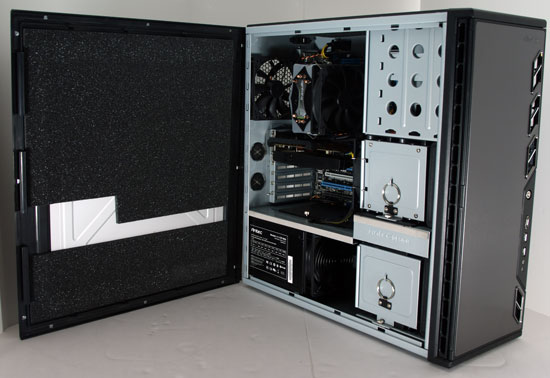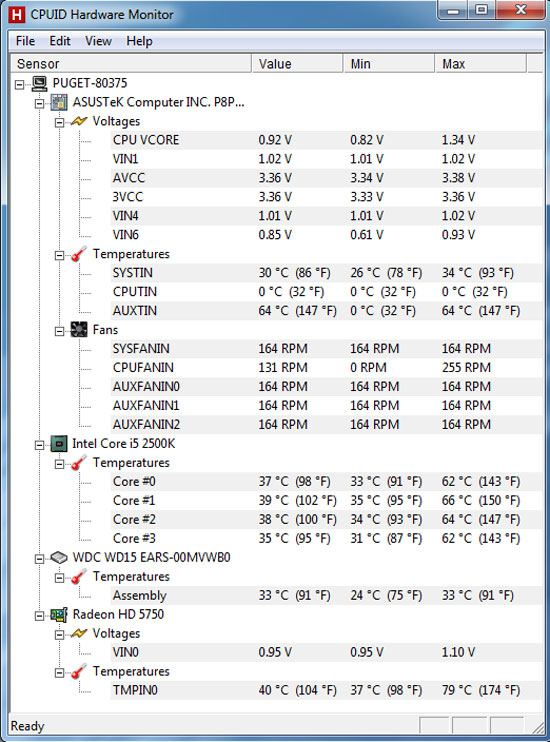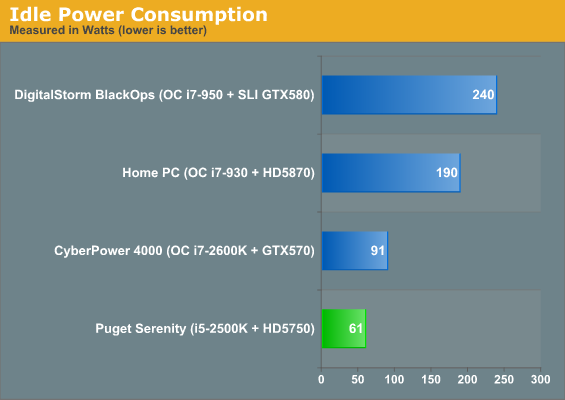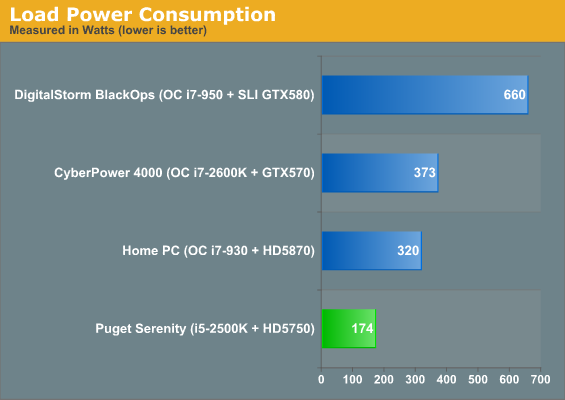Puget Systems Serenity SPCR Edition: Blissful Silence
by Dustin Sklavos on February 10, 2011 12:00 AM EST- Posted in
- Systems
- Intel
- Radeon
- Sandy Bridge
- Puget Systems
- Serenity SPCR
Build, Noise, Heat, and Power Consumption
Given the somewhat exotic nature of Puget Systems's Serenity SPCR Edition tower, it's reasonable to assume that there just aren't any good corners to cut. I'm happy to report that, having examined the system, Puget Systems simply couldn't and didn't.
What makes the build particularly interesting compared to the others is that, as I mentioned in the introduction, this really is a custom build, not just a melange of carefully chosen and assembled parts. Take a look inside and see what I mean.

Seeing the additional foam padding on the inside of the side panel when I had to remove the internal packing was a major cue, and the foam has been carefully cut to fit around the internals of the Antec P183 case used for the build. From the photo you can see three major points in Puget Systems's favor: quality case, quality power supply, and additional custom sound dampening. What's harder to see is that Puget Systems removed the Antec Tricool fans from the case and replaced them with silent Scythe 120mm fans. They've also bracketed an additional fan to the top hard drive tray, and they've removed the top exhaust fan and covered the vent with foam.
Another interesting point is the use of an air cooler instead of a watercooling system on the processor. I've reviewed more desktops with watercoolers than not and they're generally considered among the quietest ways to go, but here Puget Systems opts to use an air cooler—the Gelid Tranquilo—with a silent fan. They also carefully tuned the fan speeds in the ASUS board's UEFI to ensure silent running.
Certainly building the entire system for low noise is going to mean running a little hotter than normal, though, right? Interestingly, that's not the case.

Check out those thermals. The Serenity SPCR Edition keeps everything running remarkably frosty, and that's due in no small part to the attention paid to airflow inside the case. The P183 was already an excellent case with great thermals (we actually have a review unit on hand and we'll be posting a case review in the coming months), but the modified cooling produces airflow moving in effectively a straight line through the tower with minimal turbulence, allowing the fans to run at low speeds without compromising thermal performance. Even the Radeon doesn't crack 80C.
With those temperatures and the system's configuration in mind, these power consumption figures should come as no surprise to you:


We tested power consumption by idling at the desktop, and then running our Left 4 Dead 2 timedemo. In my experience, very few games are capable of pulling as much power from a system as Left 4 Dead 2 can. Something about the Source engine's relatively frugal usage of graphics hardware lets the processor and video power consumption scale well together.
Under load, Puget Systems's Serenity SPCR Edition draws less power than my fairly frugal desktop does at idle. Sandy Bridge has proven to be stunningly power efficient in the testing we've been able to do (we really can't wait to get our hands on more Sandy Bridge-equipped notebooks), and combining that with the already efficient Radeon HD 5750 keeps power consumption low. The next system up on the list—my home tower—draws nearly twice as much power under load. That increase in power draw may be commensurate with the increase in gaming performance, but keep in mind the i5-2500K is able to handle processor-intensive tasks much more efficiently than the i7-930.
















139 Comments
View All Comments
Dustin Sklavos - Thursday, February 10, 2011 - link
It's not a 5db decrease. Trust me when I say that even in the dead of night, in utter silence, you still won't hear so much as a low hum from this computer. Laptops don't get this quiet unless they're asleep.The only way you'd know the Serenity was on would be the power light.
mgl888 - Thursday, February 10, 2011 - link
Yes I kind of exaggerated there:PI wonder how much difference the foam makes in dampening the noise. I might grab some from Ebay and give it a try.
Trefugl - Thursday, February 10, 2011 - link
Foam goes quite a long way damping the airborne noise and since they chose a good (quiet) HDD they don't have to worry about structure borne noise (vibration).You really should tailor the solution to the particular problem. My personal PC was having issues with structure borne noise a few years back (due to my RAID array), so I added some vibration damping PVA sheeting to the side panels. I probably should also add some foam (to stop the sound of my SLI setup during gaming) but i just haven't gotten around to it now that my system is acceptable.
vol7ron - Thursday, February 10, 2011 - link
Agreed, solution should fit the problem.Really, when in doubt dish it out. It's easier to cater to all the noise possibilities early, rather than install everything and find out something is rattling behind the board later on. Be careful when getting a 120mm, you want to pay attention to two numbers: the db and the cfm. The decibels (db) is directly related to sound, but the cubic feet per minute (cfm) is how much air can be pushed through. If you have a fan with a high cfm, it's more likely that you can run it at a lower setting, thus reducing the actual db used.
Also, realize that the foam/filters might decrease airflow. It's sort of like how you put more ventilation behind drywall to help sound-proof noise between rooms in a house. It does reduce sound, but it also helps close off the thermo system. That means your case might build up more heat, increasing work on the fans, increasing the sounds generated -- just something to keep in mind when making sure you have good airflow set up.
oynaz - Thursday, February 10, 2011 - link
Sounds like a nice system for use in a studio.mgl888 - Thursday, February 10, 2011 - link
Pun intended?wolfman3k5 - Thursday, February 10, 2011 - link
So because Puget is not willing to just give their work away, and instead they charge money for real warranty, support, and excellent service they won't get an award? Wow! Ever heard of you get what you've paid for? In all my dealings with Puget I've been extremely satisfied. I've seen now other companies that offer 3 ~ 4 years warranty, but will rarely honor it. So what good is it then?! Dustin, grow some man hair and some common sense and write more acceptable conclusions. And Puget: stop wasting your time and money with web sites like this.Dustin Sklavos - Thursday, February 10, 2011 - link
Nobody asked them to give their work away, and actually I've been very briefly back and forth with Jon over there about the review. He disagreed with me on the pricetag and to an extent he's right, but there's still some real markup there that makes Puget Systems a tough sell compared to other boutiques.The flipside is that, as I mentioned, most other boutiques frankly just aren't producing systems as nice as this one and I think you could definitely make a case for spending up a bit and going with them. If you're willing to spend up you'll likely get a better shopping experience with them and frankly they don't seem to cut any corners on their builds, using top notch parts from day one.
Jon also argued that the one year warranty is to avoid being disingenuous: parts can go EOL and it may be difficult to even service that warranty under those circumstances. I don't disagree with him.
Unfortunately, a lot of consumers are only going to look at the bottom line: Puget's computers are more expensive and they only allow list a one year warranty on parts when everyone else has standardized on at least advertising three.
Trefugl - Thursday, February 10, 2011 - link
I'm somewhere between both sides on this.Dustin, I think it was unfair to simply list the Newegg price without pulling a comparable list price from another boutique. Yes, we as the Tech crowd could just throw something together from Newegg (tho it might be louder), but with a boutique there is always some markup to cover labor and overhead, and at least (as you said) they don't charge a lot extra to upgrade components.
Now, a roughly $1k markup is pretty high, but you're getting excellent components and a ridiculously quiet system. While the price is too high for my personal tastes, I'm not really the targeted customer - I really would never buy a mid to high end desktop from anyone, as I can always make it cheaper myself and have the knowledge and abilities to customize the case/design to suit my needs.
NCM - Thursday, February 10, 2011 - link
Dustin Writes: "Nobody asked them to give their work away."Hey, they get to set their price— and the market decides whether it sells or not. The AT readership is likely to have a disproportionate number of people who would assemble their own systems, but out in the real world many more buyers want complete solutions. We've certainly paid good money for well engineered low noise devices.
(Me, I'm still trying to get over noting in the comparo that someone sells a box called the DigitalStorm BlackOps. Are these named by 12-year-old boys or for 12-year-old boys...or both?)